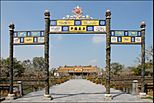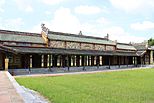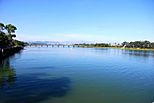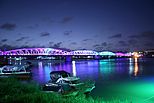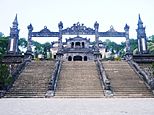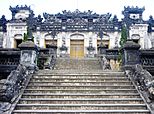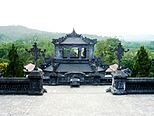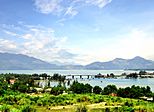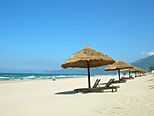Thừa Thiên Huế province facts for kids
Quick facts for kids
Thừa Thiên Huế province
Tỉnh Thừa Thiên Huế
|
|
|---|---|
|
Imperial City of Huế • Hương River • Trường Tiền Bridge • Tomb of Khải Định • Lăng Cô Beach
|
|

Location of Thừa Thiên Huế within Vietnam
|
|
| Country | |
| Region | North Central Coast |
| Capital | Huế |
| Area | |
| • Total | 5,033.2 km2 (1,943.3 sq mi) |
| Population
(2023)
|
|
| • Total | 1,272,621 |
| • Density | 223/km2 (580/sq mi) |
| Demographics | |
| • Ethnicities | Vietnamese, Chăm, Tà Ôi, Cơ Tu, Bru, Thai |
| Time zone | UTC+7 (ICT) |
| Area codes | 234 |
| ISO 3166 code | VN-26 |
| HDI (2012) | 0.735 |
Thừa Thiên Huế (Vietnamese: [tʰɨə˨˩ tʰiən˧˧ hwe˧˦]) is a coastal province located in the central part of Vietnam. It is part of the North Central Coast region. The province shares borders with Quảng Trị to the north and Quảng Nam and Đà Nẵng to the south. To its west is Salavan in Laos, and to the east is the East Sea.
Thừa Thiên Huế has a long coastline of 128 kilometers. It also features large lagoons, covering 22,000 hectares, and over 200,000 hectares of forests. The province is home to many old imperial tombs and temples in the city of Huế. People often call this area Xứ Huế, which means "The Land of Hue."
This province is a transition area in Vietnam. It connects the North Central and South Central regions. This means it has a mix of different types of land, weather, and local cultures.
Contents
- A Look at Thừa Thiên Huế's Past
- Exploring Thừa Thiên Huế's Geography
- Amazing Plants and Animals
- How Thừa Thiên Huế is Organized
- People of Thừa Thiên Huế
- Thừa Thiên Huế's Economy
- Getting Around Thừa Thiên Huế
- Learning in Thừa Thiên Huế
- International Connections
- Famous People from Thừa Thiên Huế
- What's in a Name?
- See also
A Look at Thừa Thiên Huế's Past
The history of Thừa Thiên Huế goes back about 20,800 years. This is known from ancient findings from the Sa Huynh Culture. Around 938 AD, Đại Việt became an independent country. For about four centuries, there were fights over land between Đại Việt and the Champa Kingdom.
In 1307, an emperor named Trần Anh Tông sent Đoàn Nhữ Hài to manage this area. People from the north moved south and mixed with the Champa people. This is when the area of present-day Thừa Thiên began to be settled.
Between 1306 and 1687, the region faced many changes. The Trần Dynasty fell, and the Hồ dynasty rose. Thuận Hóa and Phú Xuân became important places for the Đại Việt kingdom. This happened when Nguyễn Hoàng became the leader of Thuận Hóa in 1558.
Lord Nguyễn Hoàng (1558–1613) set up bases in different places. His family later moved their main palace to Kim Long in 1636. They then moved to Phú Xuân in 1687. The Nguyễn lords ruled here until the Trinh clan took over in 1775.
A farmers' movement, led by the Tây Sơn brothers, started in 1771. The Tây Sơn army won a battle in Phú Xuân in 1786. They took over the Nguyễn capital and then moved north to overthrow the Trinh Dynasty. Nguyễn Huệ became king in Phú Xuân. After he died in 1792, Nguyễn Ánh took control. He became emperor and chose the name Gia Long in 1802. Phú Xuân was the capital of Vietnam until 1945. Before 1975, the province was simply called Thừa Thiên.
The province was a place of heavy fighting during the Vietnam War. It was very close to the border with North Vietnam. This area and the nearby Quảng Nam province suffered greatly from floods in November 1999.
Exploring Thừa Thiên Huế's Geography
The famous Perfume River (called Sông Hương or Hương Giang) flows through the middle of the province. Thừa Thiên Huế also has the Tam Giang–Cau Hai lagoon. This is the largest lagoon in Southeast Asia, stretching 68 kilometers long. Its surface area is 220 square kilometers.
The province has four main types of land:
- Mountains: These cover more than half of the province. They are along the western and southwestern borders. Their height ranges from 500 meters to 1,480 meters.
- Hills: These are lower, between 20 meters and 200 meters high. They make up about one-third of the province's area.
- Plains: These flat areas are only up to 20 meters above sea level. They account for about one-tenth of the province.
- Lagoons: These water bodies are separated from the sea by sandbanks. They make up the remaining five percent of the province.
The province has 128 kilometers of beautiful beaches.
Bạch Mã National Park is a protected area near Huế city. It covers 220 square kilometers. The park has a tropical monsoon climate, similar to central Vietnam. The average yearly temperature in the plains and hills is 25°C (77°F). In the mountains, it's cooler, around 21°C (70°F).
The cool season runs from November to March. During this time, cold winds blow from the northeast. January is the coldest month, with an average temperature of 20°C (68°F). Temperatures can drop to 12°C (54°F) in the plains. The air is very humid, between 85% and 95%.
A warmer period follows from April to September. Average monthly temperatures can reach 29°C (84°F) in July. Sometimes, it can get as hot as 41°C (106°F). It is very humid in July, but the humidity can sometimes drop to 50%.
The province gets about 3,200 millimeters (126 inches) of rain each year. However, this can change a lot. The rainy season is from September to December. About 70% of the rain falls during these months. Heavy, short bursts of rain often cause floods and erosion. The floods in November 1999 caused 600 deaths and affected 600,000 homes.
Amazing Plants and Animals
A remote area called the "Green Corridor" is home to many different kinds of plants and animals. Scientists found 11 new species there in 2005 and 2006. These included a new type of snake, two new butterfly species, and five new orchid varieties without leaves.
The new snake species is called a white-lipped keelback (Hebius leucomystax). The new butterflies are a skipper from the genus Zela and another from the Satyrinae group. New plants found include one in the genus Aspidistra and a poisonous Arum plant.
How Thừa Thiên Huế is Organized
Thừa Thiên Huế province is divided into 9 smaller areas:
- 6 districts:
- A Lưới
- Nam Đông
- Phong Điền
- Phú Lộc
- Phú Vang
- Quảng Điền
- 2 district-level towns:
- Hương Thủy
- Hương Trà
- 1 provincial city:
- Huế (which is the capital city)
These areas are further divided into 8 smaller towns, 105 communes (like small communities), and 39 wards.
People of Thừa Thiên Huế
In 2015, the province had about 1,143,572 people. Roughly half were males (567,253) and half were females (576,319). About 587,516 people lived in rural areas, and 556,056 lived in cities.
| Largest cities or townships in Thừa Thiên Huế province (2015) | ||||
|---|---|---|---|---|
| Rank | Name | Type | District | Population |
| 1 | Huế | City | 354,124 | |
| 2 | Hương Trà | Town | 116,147 | |
| 3 | Hương Thủy | Town | 101,353 | |
| 4 | Thuận An | Township | Phú Vang District | 21,220 |
| 5 | Phú Đa | Township | Phú Vang District | 12,381 |
| 6 | Lăng Cô | Township | Phú Lộc District | 12,177 |
| 7 | Phú Lộc | Township | Phú Lộc District | 10,613 |
| 8 | Sịa | Township | Quảng Điền District | 10,583 |
| 9 | A Lưới | Township | A Lưới District | 7,393 |
| 10 | Phong Điền | Township | Phong Điền district | 6,743 |
| 11 | Khe Tre | Township | Nam Đông District | 3,818 |
Thừa Thiên Huế's Economy
The province has a strong seafood industry. Its long coastline helps produce over 40,000 tonnes of seafood each year. There are more than 500 types of fish found here.
Thừa Thiên Huế also has over 100 mines. These mines provide minerals like limestone, granite, and kaolin. The region is known for its arts, such as woodworks, fabrics, and pottery. It also exports literature and spicy foods.
Special items like custom-made áo dài (Vietnamese long dresses) and nón lá (conical hats) are popular souvenirs. People here are skilled at making toys, designing lanterns, and creating special papers and figurines. Many tropical fruits grow in this area because it gets enough rain. These fruits include rambutan, jackfruit, lychee, durian, dao, dragon fruit, star fruit, mangosteen, coconut, and kumquat.
Many historical buildings are in Huế. These are from when it was the capital of the Nguyễn dynasty (1802–1945). Important sites include the Royal Citadel, the Flag Tower, the Royal Palace, and the Royal Tombs. The Forbidden Purple City in Huế was once only for the royal family.
Hue Brewery Ltd is a well-known company in central Vietnam. It is located on the Hương Giang in Huế. The brewery started in 1990 and has grown a lot since then.
Getting Around Thừa Thiên Huế
National Route 1 is a major road that runs through Huế. This road goes from the north to the south of Vietnam. Huế and Đà Nẵng are important stops on the railway line that connects Hanoi and Ho Chi Minh City.
The province has two sea ports: Thuan An Port and Chân Mây Port. Phu Bai International Airport is located 15 kilometers south of Huế. It is one of Vietnam's busiest domestic airports. The government plans to upgrade it to an international airport with flights to other parts of Asia.
Learning in Thừa Thiên Huế
Huế is home to Huế University. This university has many different colleges, such as:
- Huế Economic University
- Huế Medicine University
- Huế Pedagogical University
- Huế Forestry and Agriculture University
- Huế University of Sciences
- Huế University of Arts
- Huế Conservatory of Music
- Huế College of Foreign Languages
In 2009, the province had 190 schools, 1,302 classrooms, 2,184 teachers, and 36,200 students.
The most famous high school in Thừa Thiên Huế province is Quốc Học – Huế High School for the Gifted. It is known for its high-quality education. Its old French-style buildings also make it famous.
International Connections
Thừa Thiên Huế has "sister city" relationships with several cities around the world. This means they share cultural and economic ties.
 Bandar-e Anzali, Gilan province, Iran
Bandar-e Anzali, Gilan province, Iran Blois, Centre-Val de Loire, France
Blois, Centre-Val de Loire, France
 Honolulu, Hawaii, United States''''
Honolulu, Hawaii, United States''''
 New Haven, Connecticut, United States''''
New Haven, Connecticut, United States''''
 Phra Nakhon Si Ayutthaya, Thailand
Phra Nakhon Si Ayutthaya, Thailand
 Quebec, Canada
Quebec, Canada
 Rennes, Brittany, France
Rennes, Brittany, France
 Yogyakarta, Java, Indonesia
Yogyakarta, Java, Indonesia
Famous People from Thừa Thiên Huế
Some well-known people have come from this province:
- Thích Nhất Hạnh, a famous Buddhist monk
- Trịnh Công Sơn, a talented composer
- Ngô Viết Thụ, an architect
- Ho Ngoc Ha, a singer and actress
What's in a Name?
The name "Thừa Thiên Huế" comes from old Sino-Vietnamese words. It combines 承, 天, 順, and 化.
See also
 In Spanish: Huế (municipio) para niños
In Spanish: Huế (municipio) para niños







